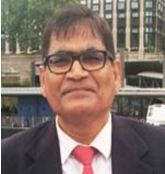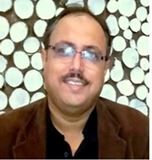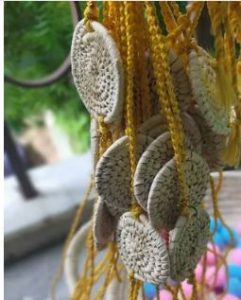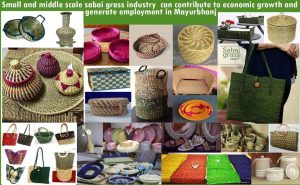
 Prof Goutam Saha & Prof Satya Narayan Misra in Bhubaneswar, August 10, 2022: Historically speaking, Raksha Bandhan festival is associated with a sense of protection, unity, care, and love.
Prof Goutam Saha & Prof Satya Narayan Misra in Bhubaneswar, August 10, 2022: Historically speaking, Raksha Bandhan festival is associated with a sense of protection, unity, care, and love.
Of how emperor Humayun tried to protect Karnawati, the queen of Chittor from the attack of the Sultan of Gujarat Bahadur Shah or how Rabindranath Tagore tried to unify Hindus and Muslim communities and protested against the divisions of Bengal are all inspiring stories in the pages of history, where Rakhi is used as a talisman of unity, love, and protective care.
In the last few years, we have been witnessing Rakhis made by Sabai Grass in various markets of Odisha. What is less known is that these Rakhis are made by tribal women of Mayurbhanj. These beautiful Rakhis and other beautiful Sabai Grass products have also a successful and lovely story to share with the world.
This story is a tale of harmony and coordinated efforts among government institutions, local self-help groups of the tribal community, design interventions made by designers coming from reputed design institutes, and the support of NGOs and private businesses.
This coordinated approach led to beautiful eco-friendly products for the consumers and livelihood opportunities, capability building and well being of the artisans, which can make welfare economists happy.
 Sabai grass or ‘Eulaliopsis Binata’ is a naturally growing grass in the tropical climate of the Mayurbhanj district of Odisha. The grass is used for making ropes and handicrafts, used for both decorative and utility purposes. There is a rising market demand for the products in local, national and global markets considering their environmental sustainability and low carbon footprint.
Sabai grass or ‘Eulaliopsis Binata’ is a naturally growing grass in the tropical climate of the Mayurbhanj district of Odisha. The grass is used for making ropes and handicrafts, used for both decorative and utility purposes. There is a rising market demand for the products in local, national and global markets considering their environmental sustainability and low carbon footprint.
The products are a suitable replacement for plastic products and can develop a sustainable and circular economy. Sabai grass is a primary source of livelihood for many tribal communities settled in the area. A few years before, the grass is sold at around Rs 15-20/kg while the Sabai grass ropes fetch around Rs 20-50/Kg.
Though the grass grows throughout the year, its quality and quantity of produce vary depending on the environmental condition. Mayurbhanj district alone constitutes 58.58% of the tribal population of the state. The majority of these people live under the poverty line whose main occupations are agriculture, agricultural or migrated labor, and sellers of Sabai grass and Sabai grass ropes.
In this socio-economic background, how the agencies of the Odisha State Government, the Central Government, tribal community, private players, and design Institutions made a symbiotic effort to increase the income of the tribal women of Baripada was thoroughly documented in the research of Professor Lipsa Mohapatra of NIFT, Bhubaneswar. Sabai Producer Groups are mainly run and managed by the women of the village.
Around 50 to 100 members constitute a typical Producer Group (PG). They are also effective members of different Self Help Groups (SHG) present in the same district. NABARD also helps in establishing the credit linkages and provides a small number of loans to each SHG. The women are trained to make handicrafts from Sabai Grass.
 They use fine-graded Sabai grass and palm leaves to make decorative artifacts. The trainers were designers from NID (National Institute of Design) or NIFT (National Institute of Fashion Technology) and/or Master artisans in the same field, artists and professionals. Even NIFT, NID students also frequently visit them for exchange of knowledge.
They use fine-graded Sabai grass and palm leaves to make decorative artifacts. The trainers were designers from NID (National Institute of Design) or NIFT (National Institute of Fashion Technology) and/or Master artisans in the same field, artists and professionals. Even NIFT, NID students also frequently visit them for exchange of knowledge.
The designer products helped these women to earn about Rs 200-Rs 300 per day, which motivated other women to join the program. It has created a new social ecosystem that could create sustainable livelihood opportunities. The handicrafts have evolved with time due to institutional interventions and training.
More than thirty different products have been developed since 2010 including baskets, mats, photo frames, curtains, jewellery boxes, lampshades, furniture, wallets, bags, penholders, slippers, jewellery, etc.
During Covid 19 pandemic, design intervention helped them to convert crisis into opportunity. They developed Rakhi for Rakhsha Bandhan which fetched them a decent income. The interventions have empowered the women, made them economically independent, confident, and aware, provided them with decision-making power and developed their socioeconomic conditions.
Involved in the craft, artisans now enjoy a better financial position in their society. There was a holistic growth in the socio-economic condition of the village community. The participation of women in village Panchayat meetings increased. The SHG format helped them to access micro-credit facilities from banks. The women learned the virtues of savings of their earnings.
They now enjoyed a better position in family decision-making and were respected as earning members of their families. Thus, it leads to the overall growth and stability and development of the community while bringing down the incidences of rural urban migration.
Mention may be made of the story of Sea buckthorn, a thorny shrub wildly growing in Ladakh, which was earlier destroyed as a weed and is now being harnessed as a beverage, medicine, and cosmetics, with a wide international market.
This has changed the economic well-being and fortune of people in the arid deserts of Ladakh. This was possible due to the pioneering work by Dr Brahma Singh, Director of Food Research Laboratory, Ladakh, who could bring the local population on board to harness the potential of technology to transform their livelihood.
Geffrey Sachs, who is a leading voice in achieving sustainable development goals in his recent book ‘Ages of Globalization’, writes that the future model of development must be a society led where government, corporates, and local communities work in tandem instead of leaving the government alone.
 The success stories of Sabai Grass and Sea buck thorn weeds clear show how collaborative effort between the government agencies, scientific community, designers and local community can play a transformative role not only in bolstering economic well being, but also in fostering indigenous expertise and culture.
The success stories of Sabai Grass and Sea buck thorn weeds clear show how collaborative effort between the government agencies, scientific community, designers and local community can play a transformative role not only in bolstering economic well being, but also in fostering indigenous expertise and culture.
We need to supplant the market economy profit alone model of Adam Smith with a collaborative model propounded by development economists where equity coalesces with efficiency, and the dignity & quality of those in the margins get due recognition & heft.
The Sabai Grass rakhis on the day of Raksha Bandhan, is symbolic of our tryst towards a more empathetic, equitable and harmonious world.
Professor Gautam Saha is Associate Professor in NIFT, Bhubanewar & Professor Misra is Emeritus Professor


Leave a Reply
Be the First to Comment!